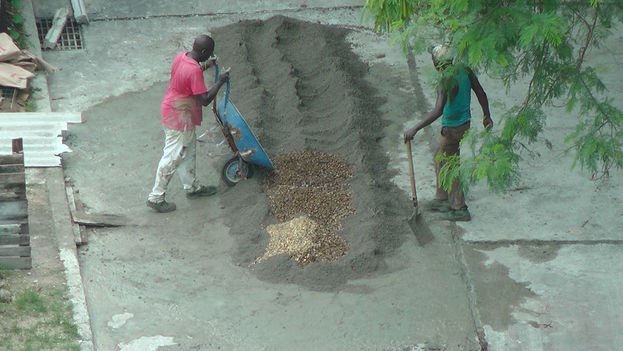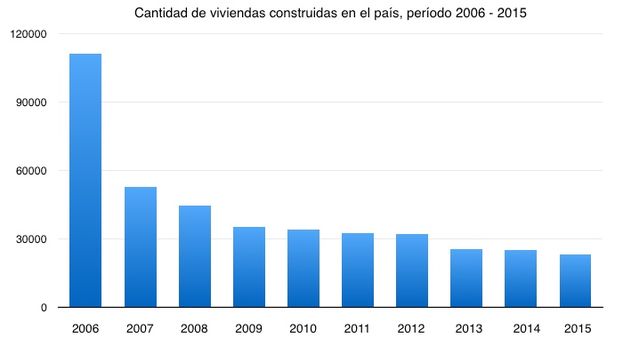
![]() 14ymedio, Zunilda Mata, Havana, 3 January 2017 – This week Luisa Camejo’s biggest headache will be getting the rebar she’s lacking. For months she’s been piling up stacks of cement, bricks and other materials to build an improvised room in the Cerro district of Havana. If she’s lucky she’ll soon finish her house built with her own efforts, in a year when the state plans to build fewer than 10,000 houses on the entire island.
14ymedio, Zunilda Mata, Havana, 3 January 2017 – This week Luisa Camejo’s biggest headache will be getting the rebar she’s lacking. For months she’s been piling up stacks of cement, bricks and other materials to build an improvised room in the Cerro district of Havana. If she’s lucky she’ll soon finish her house built with her own efforts, in a year when the state plans to build fewer than 10,000 houses on the entire island.
The authorities recognize that the housing problem is the primary social need in Cuba – analysts estimate the deficit at some 600,000 homes – but in the last decade the number of homes built has fallen by 20%. In 2006, there was a historic peak of 111,373 housing units erected, but by the end of 2015 the total barely exceeded 23,000, more than half of which were built through private efforts.
With the gloomy economic announcements in the last session of the National Assembly, alarms have also been set off about the development of the housing fund in the short and medium term. In his speech to the parliamentarians, Minister of Economy and Planning Ricardo Cabrisas Ruiz declared that in the next twelve months the state will only finish some 9,700 homes.
The areas prioritized for the new buildings coincide with the five municipalities affected by Hurricane Matthew in its passage across Guantanamo province, a region where more than 38,000 homes were totally or partially destroyed, and for which the government is raising international aid to rebuild them.

The Alaves Emergency Fund, established by the Provincial Council of Alava and the Municipality of Vitoria, in Spain’s Basque Country, just announced it will allocate 52,000 euros for schools and workplaces in the area of Cuba affected by the hurricane, but foreign aid is barely a drop in the ocean of Cuba’s housing deficit.
The difficult situation facing thousands of families has led many to stop waiting for the state’s construction plans – in the style of those undertaken in the years of the Soviet subsidy – and to seek their own solutions. A tortuous road, where the obstacles range from getting the materials to the cost of labor.
Luisa, 61, lived for six years in a place that she, her two daughters and her husband sneaked into. “There was no bathroom and we had to see to our needs in a can and empty it every day,” she tells 14ymedio. With the 2011 enactment of the law that allows the buying and selling of houses, Camejo acquired a small piece of land near Sports City, with a rickety wooden house on it
These last three years she has dedicated to construction, spending full time locating and acquiring the materials for the house, supervising the brick layers and making with her own hands everything from formwork to mortar. “We are living amid dust and sacks, but at least it’s mine,” she reflects. So far, she has spent 2,000 Cuban Convertible pesos, a decade’s worth of the salary from her former job as a teacher, from which she retired a couple of years ago.
In the middle of last year Ramiro Valdés Menéndez, vice-president of the Councils of State and of Ministers, made clear that the solution to the problem of the house in the country resides “in individual effort”
At the beginning of the century, Vice President Carlos Lage was the official functionary in charge of the housing program. The goal, in those years, was to build 150,000 houses a year to relieve the problem. Luisa hoped to benefit from an apartment in a microbrigade building built by a social contingent, but the brief economic flourishing the island experienced with aid from Venezuela was extinguished shortly thereafter.
“We realize we have to solve this problem ourselves,” she comments. Shortly afterwards, Lage was ousted and no other face of the government took on the public commitment to families needing a roof.
Instead, in the middle of last year, Ramiro Valdés Menéndez, also vice-president of the Councils of States and of Ministers, made it clear that the solution to the housing problem in the country resides “in individual effort.”
Despite the attention, the result is insufficient. The retired teacher is now worried about problems with the supply of construction materials, with the east of the island given priority, according to decisions made in the capital. “We have a lot of problems getting pipes and everything related to electrical installation,” she explains. She also needs “tiles, concrete glue and gravel.”
Since last November, there have been weeks of shortages of building materials in Havana, a situation that could slow even further the completion of construction projects. But Luisa seems determined to finishing her own personal plan. “This year my bathroom and my own shower, even if I have to tile it with my own hands.”
